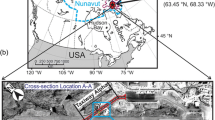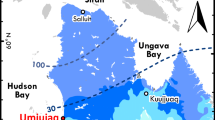Abstract
Groundwater flow in cold regions containing permafrost accelerates climate-warming-driven thaw and changes thaw patterns. Simulation analyses of groundwater flow and heat transport with freeze/thaw in typical cold-regions terrain with nested flow indicate that early thaw rate is particularly enhanced by flow, the time when adverse environmental impacts of climate-warming-induced permafrost loss may be severest. For the slowest climate-warming rate predicted by the Intergovernmental Panel on Climate Change (IPCC), once significant groundwater flow begins, thick permafrost layers can vanish in several hundred years, but survive over 1,000 years where flow is minimal. Large-scale thaw depends mostly on the balance of heat advection and conduction in the supra-permafrost zone. Surface-water bodies underlain by open taliks allow slow sub-permafrost flow, with lesser influence on regional thaw. Advection dominance over conduction depends on permeability and topography. Groundwater flow around permafrost and flow through permafrost impact thaw differently; the latter enhances early thaw rate. Air-temperature seasonality also increases early thaw. Hydrogeologic heterogeneity and topography strongly affect thaw rates/patterns. Permafrost controls the groundwater/surface-water-geomorphology system; hence, prediction and mitigation of impacts of thaw on ecology, chemical exports and infrastructure require improved hydrogeology/permafrost characterization and understanding.
Résumé
L’écoulement souterrain de l’eau dans les régions froides présentant un pergélisol accélère le dégel généré par le réchauffement climatique et change le modèle du dégel. Les simulations d’écoulement souterrain et de transport de chaleur avec gel/dégel dans les régions froides typiques et écoulement en réseau, indiquent que le taux de dégel précoce s’accroît particulièrement du fait de l’écoulement, à un moment où les impacts environnementaux défavorables d’une disparition du permafrost induite par le réchauffement climatique peuvent être les plus sévères. Pour le taux de réchauffement climatique le plus bas prévu par la Commission Intergouvernementale sur le Changement Climatique (IPCC), une fois qu’un écoulement souterrain significatif débute, les niveaux de pergélisol épais peuvent disparaître en plusieurs centaines d’années, mais survivre plus de 1000 ans quand l’écoulement est minimal. Le dégel à grande échelle dépend principalement du bilan d’advection de la chaleur et de la conduction dans la zone supra-pergélisol. Les masses d’eau à la base des taliks ouverts permettent un écoulement infra-pergélisol lent, avec une influence moindre sur le dégel régional. La prépondérance de l’advection sur la conduction dépend de la perméabilité et de la topographie. L’écoulement souterrain autour du pergélisol et l’écoulement à travers le pergélisol impactent le dégel différemment; le dernier type d’écoulement accroît le taux de dégel de façon précoce. La saisonnalité air-température augmente aussi le dégel précoce. L’hétérogénéité de l’hydrogéologie et la topographie affectent fortement caractéristiques et taux du dégel. Le pergélisol contrôle le système eau souterraine-eau de surface-géomorphologie ; par suite, la prévision et l’atténuation des impacts du dégel sur l’écologie, sur les mobilisations chimiques et sur le substrat nécessitent une caractérisation et une meilleure compréhension de l’hydrogéologie liée au pergélisol.
Resumen
El flujo de agua subterránea en regiones frías que contienen un permafrost acelera el calentamiento climático impulsado por el descongelamiento y cambios en los patrones de descongelamiento. Los análisis de simulación del flujo de agua subterránea y del transporte de calor con congelamiento / descongelamiento en terrenos típicos de regiones frías con flujos jerarquizados indican que la tasa de deshielo temprana es particularmente realzada por el flujo y que la época en que los impactos ambientales adversos del calentamiento climático inducido por la pérdida de permafrost puede ser más severa. Para las tasas más lentas del calentamiento climático predichas por el Intergovernmental Panel on Climate Change (IPCC), una vez que un flujo significativo de agua subterránea comienza, las gruesas capas de permafrost pueden desaparecer en varios cientos de años, pero sobreviven más de 1000 años donde el flujo es mínimo. El descongelamiento a gran escala depende principalmente del balance de la advección y conducción de calor en la zona supra—permafrost. Los cuerpos de agua superficial sustentados por taliks abiertos permiten mostrar el lento flujo sub-permafrost, con una menor influencia en el descongelamiento regional. El dominio de la advección sobre la conducción depende de la permeabilidad y la topografía. El flujo de agua subterránea alrededor del permafrost y el flujo a través del permafrost impactan en forma diferente en el descongelamiento; este último aumenta la tasa de descongelamiento temprano. Estacionalmente la temperatura del aire también incrementa el deshielo temprano. La heterogeneidad hidrogeológica y la topografía afectan fuertemente las tasas / patrones de deshielo. El permafrost controla el sistema geomorfología—agua superficial—agua subterránea; por lo tanto la predicción y mitigación de los impactos del descongelamiento sobre la ecología, las exportaciones de productos químicos y la infraestructura requiere una mejor caracterización y entendimiento de la hidrogeología / permafrost.
摘要
具有永久冻土的寒区地下水流使气候变暖驱使的融化加速,并改变融化类型。具有嵌入水流的典型寒区地下水流及冻结/融化的热传导模拟分析表明早期消融速率主要由水流增强的,气候变暖导致的永久冻土消失引起的环境负效应的时间是严格的。根据联合国政府间气候变化专门委员会(IPCC)预计的最慢气候变暖速率,一旦明显的地下水流形成,厚的永久冻土层在几百年内会消失,但是在最小水流时可存在千年以上。大规模的消融更依赖于上永久冻土地带的热对流及传导平衡。下伏有开放融区的地表水体可以允许缓慢的地下永久冻土水流,这对区域消融影响较小。强于传导的对流优势取决于渗透性和地形。永久冻土附近的地下水流以及通过永久冻土的水流对消融的不同影响,后者增加早期消融速率。空气温度的季节性同样增强了早期消融。永久冻土控制地下水-地表水-地貌系统;所以消融对生态、化学输出以及基础设施的影响预测及减缓需要提高对水文地质/永久冻土的描述和理解。
Resumo
O fluxo de água subterrânea em regiões frias contendo permafrost acelera a fusão motivada por aquecimento climático e altera os padrões de fusão. A análise por simulação do escoamento de água subterrânea e de transporte de calor com congelamento/fusão em terrenos de regiões frias típicas com escoamento encaixado indicam que a taxa de fusão precoce é particularmente ampliada pelo fluxo, num momento em que os impactos ambientais adversos da perda de permafrost induzida pelo aquecimento climático podem ser mais severos. Para a mais baixa taxa de aquecimento climático prevista pelo Painel Intergovernamental sobre Mudanças Climáticas (IPCC), logo que se inicie um significativo fluxo subterrâneo, as camadas espessas de permafrost podem desaparecer em algumas centenas de anos, mas sobrevivem para cima de 1000 anos quando o fluxo é mínimo. A fusão em larga escala depende principalmente do balanço entre adveção e condução de calor na zona superior do permafrost. As massas de água superficial sobrepostas a taliks abertos permitem um fluxo lento na zona inferior do permafrost, com menor influência na fusão regional. O domínio da adveção sobre a condução depende da permeabilidade e da topografia. O fluxo de água subterrânea em torno do permafrost e o fluxo através do permafrost afetam a fusão de modo diverso; este último ampliando as taxas de fusão precoce. A heterogeneidade hidrogeológica e a topografia afetam fortemente as taxas/padrões de fusão. O permafrost controla o sistema geomorfológico-água subterrânea-água superficial; em consequência, a predição e a mitigação de impactos da fusão na ecologia, na exportação de químicos e nas infraestruturas requerem uma melhorada caracterização e compreensão da hidrogeologia/permafrost.











Similar content being viewed by others
References
Bense VF, Ferguson G, Kooi H (2009) Evolution of shallow groundwater flow systems in areas of degrading permafrost. Geophys Res Lett 36:L22401. doi:10.1029/2009GL039225
Bense VF, Kooi H, Ferguson G, Read T (2012) Permafrost degradation as a control on hydrogeological regime shifts in a warming climate. J Geophys Res 117:F03036. doi:10.1029/2011JF002143
Frampton A, Painter S, Lyon SW, Destouni G (2011) Non-isothermal, three-phase simulations of near-surface flows in a model permafrost system under seasonal variability and climate change. J Hydrol 403(3–4):352–359
Ge S, McKenzie J, Voss C, Wu Q (2011) Exchange of groundwater and surface-water mediated by permafrost response to seasonal and long-term air temperature variation. Geophys Res Lett 38:L14402. doi:10.1029/2011GL047911
IPCC (2007) Contribution of Working Groups I, II and III to the Fourth Assessment Report of the Intergovernmental Panel on Climate Change Core Writing Team. In: Pachauri RK, Reisinger A (eds) IPCC, Geneva, Switzerland
Kane DL, Hinkel KM, Goering DJ, Hinzman LD, Outcalt SI (2001) Non-conductive heat transfer associated with frozen soils. Glob Planet Chang 29:275–292
Kell GS (1967) Precise representation of volume properties of water at one atmosphere. J Chem Eng Data 12(1):66–69
McKenzie JM, Siegel DI, Rosenberry DO, Glaser PH, Voss CI (2006) Heat transport in the Red Lake Bog, Glacial Lake Agassiz Peatlands. Hydrol Process 21(3):369–378
McKenzie JM, Voss CI, Siegel DI (2007) Groundwater flow with energy transport and water–ice phase change: numerical simulations, benchmarks, and application to freezing in peat bogs. Adv Water Resour 30:966–998. doi:10.1016/j.advwatres.2006.08.008
Minsley BJ, Abraham JD, Smith BD, Cannia JC, Voss CI, Jorgenson MT, Walvoord MA, Wylie BK, Anderson L, Ball LB, Deszcz-Pan M, Wellman TP, Ager TA (2012) Airborne electromagnetic imaging of discontinuous permafrost. Geophys Res Lett 39:L02503. doi:10.1029/2011GL050079
Painter SL (2011) Three-phase numerical model of water migration in partially frozen geological media: model formulation, validation, and applications. Comput Geosci 15:69–85
Rowland JC, Travis BJ, Wilson CJ (2011) The role of advective heat transport in talik development beneath lakes and ponds in discontinuous permafrost. Geophys Res Lett 38:L17504. doi:10.1029/2011GL048497
Tilton LW, Taylor JK (1937) Accurate representation of the refractivity and density of distilled water as a function of temperature. J Res Natl Bur Stand 18:205–214
Toth J (1963) A theoretical analysis of groundwater flow in small drainage basins. J Geophys Res 68(16):4795–4812
Voss CI, ProvostAM(2002) SUTRA: a model for saturated-unsaturated, variable-density ground-water flow with solute or energy transport. US Geol Surv Water Resour Invest Rep 02–4231, 250 pp. US Geological Survey, Reston
Walvoord MA, Voss CI, Wellman TP (2012) Influence of permafrost distribution on groundwater flow in the context of climate-driven permafrost thaw: example from Yukon Flats Basin, Alaska, USA. Water Resour Res 48:W07524. doi:10.1029/2011WR011595
Wellman TC, Voss CI, Walvoord MA (2012) Impacts of climate, lake size, and supra- and sub-permafrost groundwater flow on lake-talik evolution, Yukon Flats, Alaska (USA). Hydrogeol J. doi:10040_10.1007/s10040-012-0941-4
White D, Hinzman L, Alessa L, Cassano J, Chambers M, Falkner KK, Francis J, Gutowski B, Holland D, Holmes RM, Huntington H, Kane D, Kliskey A, Lee C, McClelland J, Peterson B, Straneo F, Steele M, Woodgate R, Yang D, Yoshikawa K, Zhang T (2007) The Arctic freshwater system: changes and impacts. J Geophys Res 112:G04S54
Acknowledgements
This project has received support from: Fonds de recherche Nature et technologies, Quebec, McGill University, Canada, US Geological Survey (USGS) National Research Program, USGS Climate and Land Use Change and Water Mission Areas, and grant RC-2111 of the US Government Interagency (DOD, EPA and DOE) Strategic Environmental Research and Development Program (SERDP). This article has greatly benefited from insightful helpful reviews by Michelle Walvoord (USGS), Joel Rowland (LANL), Bryan Travis (LANL) and Larry Hinzman (IARC).
Author information
Authors and Affiliations
Corresponding author
Additional information
Published in the theme issue “Hydrogeology of Cold Regions”
Rights and permissions
About this article
Cite this article
McKenzie, J.M., Voss, C.I. Permafrost thaw in a nested groundwater-flow system. Hydrogeol J 21, 299–316 (2013). https://doi.org/10.1007/s10040-012-0942-3
Received:
Accepted:
Published:
Issue Date:
DOI: https://doi.org/10.1007/s10040-012-0942-3




